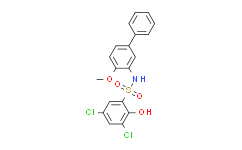| Cas No.: | 943962-47-8 |
| Chemical Name: | 3,5-Dichloro-2-hydroxy-N-(2-methoxy-5-phenylphenyl)benzenesulfonamide |
| Synonyms: | BMS303141;BMS-303141;3,5-dichloro-2-hydroxy-N-(4-methoxybiphenyl-3-yl)benzenesulfonamide;BMS30314;3,5-Dichloro-2-hydroxy-N-(4-methoxy[1,1′-biphenyl]-3-yl)-benzenesulfonamide;BMS 303141;3,5-dichloro-2-hydroxy-N-(4-methoxy-[1,1'-biphenyl]-3-yl)benzenesulfonamide;3,5-dichloro-2-hydroxy-N-(2-methoxy-5-phenylphenyl)benzenesulfonamide;C19H15Cl2NO4S;AOB3947;HMS3740O11;BCP06495;BMS 30314;BDBM50209010;3497AH;AK548147 |
| SMILES: | ClC1=C([H])C(=C([H])C(=C1O[H])S(N([H])C1=C(C([H])=C([H])C(C2C([H])=C([H])C([H])=C([H])C=2[H])=C1[H])OC([H])([H])[H])(=O)=O)Cl |
| Formula: | C19H15Cl2NO4S |
| M.Wt: | 424.2977 |
| Sotrage: | 2 years -20°C Powder, 2 weeks 4°C in DMSO, 6 months -80°C in DMSO |
| Description: | BMS-303141 is a potent, cell-permeable ATP-citrate lyase (ACL) inhibitor with an IC50 of 0.13 μM. |
| In Vivo: | Chronic oral dosing of BMS-303141 in high-fat fed mice lowers approximate 20-30% plasma cholesterol and triglycerides, as well as 30-50% fasting plasma glucose. Chronic treatment with BMS-303141 shows a gradual inhibition of weight gain along with a reduction in adiposity without apparent changes in food intake. BMS-303141 shows an oral bioavailability of 55% but a relatively short half-life of 2.1 h[1]. |
| In Vitro: | In HepG2 cells, BMS-303141 shows inhibition of total lipid syntheses with an IC50 of 8 μM. BMS-303141 shows no cytotoxicity up to 50 lM under a cell based Alamar Blue cytotoxicity assay, indicating the observed inhibition of lipid synthesis is not a result of compound-induced cytotoxicity[1]. |

 To enhance service speed and avoid tariff delays, we've opened a US warehouse. All US orders ship directly from our US facility.
To enhance service speed and avoid tariff delays, we've opened a US warehouse. All US orders ship directly from our US facility.




















